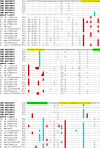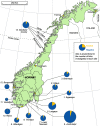Detection of Candidatus Neoehrlichia mikurensis in Norway up to the northern limit of Ixodes ricinus distribution using a novel real time PCR test targeting the groEL gene
- PMID: 31462211
- PMCID: PMC6714093
- DOI: 10.1186/s12866-019-1502-y
Detection of Candidatus Neoehrlichia mikurensis in Norway up to the northern limit of Ixodes ricinus distribution using a novel real time PCR test targeting the groEL gene
Erratum in
-
Correction to: Detection of Candidatus Neoehrlichia mikurensis in Norway up to the northern limit of Ixodes ricinus distribution using a novel real time PCR test targeting the groEL gene.BMC Microbiol. 2020 Jan 10;20(1):9. doi: 10.1186/s12866-020-1697-y. BMC Microbiol. 2020. PMID: 31924162 Free PMC article.
Abstract
Background: Candidatus Neoehrlichia mikurensis is an emerging tick-borne pathogen. It is widely distributed in Ixodes ricinus ticks in Europe, but knowledge of its distribution in Norway, where I. ricinus reaches its northern limit, is limited. In this study we have developed a real time PCR test for Ca. N. mikurensis and used it to investigate the distribution of Ca. N. mikurensis in Norway.
Results: Real time PCR targeting the groEL gene was developed and shown to be highly sensitive. It was used to detect Ca. N. mikurensis in 1651 I. ricinus nymphs and adults collected from twelve locations in Norway, from the eastern Oslo Fjord in the south to near the Arctic Circle in the north. The overall prevalence was 6.5% and varied locally between 0 and 16%. Prevalence in adults and nymphs was similar, suggesting that ticks acquire Ca. N. mikurensis predominantly during their first blood meal. In addition, 123 larvae were investigated; Ca. N. mikurensis was not found in larvae, suggesting that transovarial transmission is rare or absent. Sequence analysis suggests that a single variant dominates in Norway.
Conclusions: Ca. N. mikurensis is widespread and common in ticks in Norway and reaches up to their northern limit near the Arctic Circle. Ticks appear to acquire Ca. N. mikurensis during their first blood meal. No evidence for transovarial transmission was found.
Keywords: Ixodes ricinus; Neoehrlichia mikurensis; Norway; Scandinavia; Tick-borne diseases; Ticks.
Conflict of interest statement
The authors declare that they have no competing interests.
Figures




References
-
- Kawahara M, Rikihisa Y, Isogai E, Takahashi M, Misumi H, Suto C, Shibata S, Zhang C, Tsuji M. Ultrastructure and phylogenetic analysis of 'Candidatus Neoehrlichia mikurensis' in the family Anaplasmataceae, isolated from wild rats and found in Ixodes ovatus ticks. Int J Syst Evol Microbiol. 2004;54:1837–1843. doi: 10.1099/ijs.0.63260-0. - DOI - PubMed
-
- Dumler JS, Barbet AF, Bekker CP, Dasch GA, Palmer GH, Ray SC, Rikihisa Y, Rurangirwa FR. Reorganization of genera in the families Rickettsiaceae and Anaplasmataceae in the order Rickettsiales: unification of some species of Ehrlichia with Anaplasma, Cowdria with Ehrlichia and Ehrlichia with Neorickettsia, descriptions of six new species combinations and designation of Ehrlichia equi and 'HGE agent' as subjective synonyms of Ehrlichia phagocytophila. Int J Syst Evol Microbiol. 2001;51:2145–2165. doi: 10.1099/00207713-51-6-2145. - DOI - PubMed
Publication types
MeSH terms
Substances
LinkOut - more resources
Full Text Sources
Research Materials

